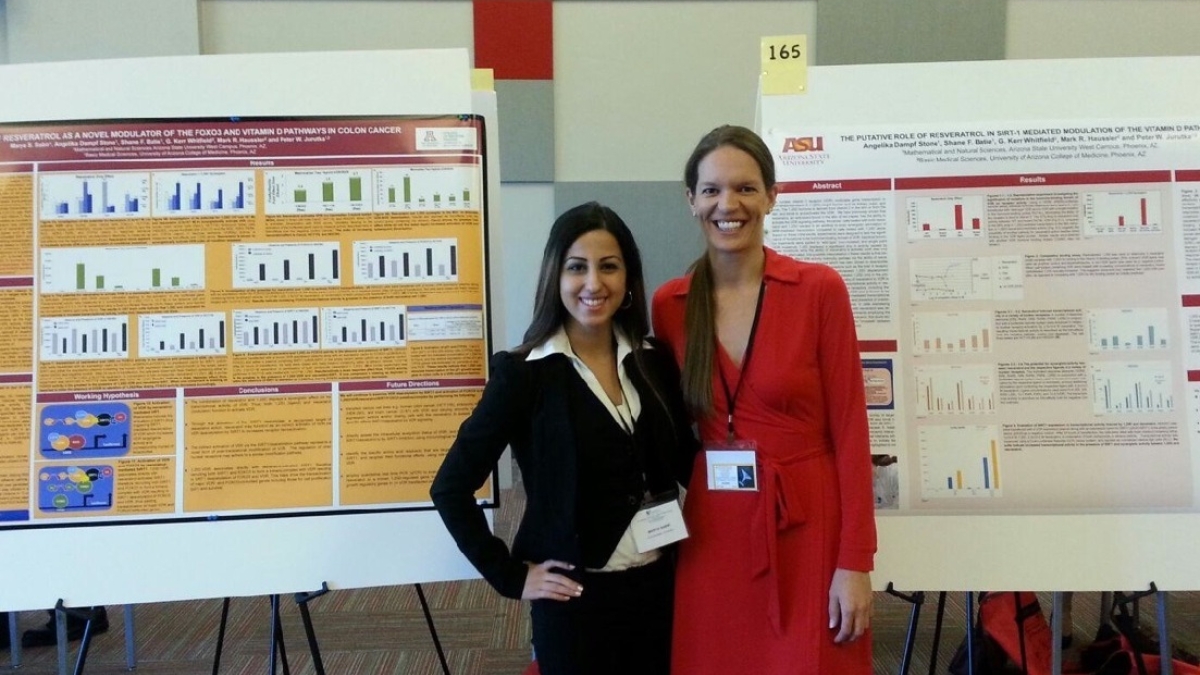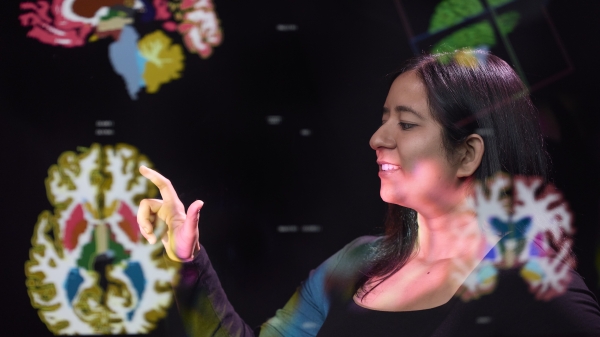ASU School of Molecular Sciences shows the power of women

Marya Sabir (left) is one of the many incredible alumnae featured in the School of Molecular Sciences' Spotlight on Women in Science project. She is pictured here with her colleague Angelika Dampf Stone.
The world of science, technology, engineering and mathematics (STEM) has a problem: Women are underrepresented. This year, Arizona State University's School of Molecular Sciences has set out on a mission to change the societal underrepresentation of women in science, starting with its own project.
“It is a well-known problem that women are underrepresented in various forms of STEM fields,” said Ian Gould, President's Professor and associate director of outreach, online and communications for the School of Molecular Sciences. “The fundamental root cause of this underrepresentation is a societal issue, so we wanted to do a social contribution to change the culture.”
And thus the Spotlight on Women in Science project was born.
Mary Zhu, technical support analyst coordinator, and Rachel Lee, intern of communications at the School of Molecular Sciences, joined forces with Gould to begin the process of collecting stories of ASU alumnae in science to highlight.
“We tried to contact alumnae in many different ways,” Lee said. “We started a campaign on Facebook, sent out emails, advertised through word of mouth, and hoped that more people would see what we were working on and want to contribute themselves.”
Once they had stories and photos, Zhu and Lee began highlighting women in science on the school’s social media channels to show the important work they contribute to the industry.
“The first element of bringing about social change is acknowledging that a problem does indeed exist, and in this case, it is the underrepresentation of women in the sciences,” said ASU alumna Marya Sabir, who received her Bachelor of Science in biochemistry in 2015. “The Spotlight on Women in Science initiative led by the School of Molecular Sciences gives women a platform to be recognized for their successes while ushering in a call to action for all women and men to become more vested in empowering women to fulfill their full potential especially in the scientific sphere.”
Sabir was the first woman featured in the project when it made its debut in early January on the school’s Facebook page. Sabir said she knows the importance of creating an equal environment for women in the sciences to work and succeed.
“I have been fortunate to have had mentors who understood the importance of involving women in the sciences,” Sabir said. “However, it is no secret that we as women face broad and invisible barriers to success in the academic sciences and engineering spheres as a result of unintentional/implicit gender biases and outdated, historically-driven policies and structures that continue to govern institutions.”
Sabir refuses to be held back by such barriers. She has gone on to conduct research at the Translational Genomics Research Institute as a Ben and Catherine Ivy Neurological Sciences Scholar, and has received multiple accolades for her work including the Post-Baccalaureate Intramural Research Training Award Fellowship from the National Institutes of Health.
Once the initial Facebook post of Sabir was published, the project evolved to include an additional element that would stand out and uniquely tackle the bigger societal issue. Using the photos sent in by the many graduates from the college, the team began working on a collage video that would focus on the women themselves.
“The content of the video is a variety of women,” Gould said. “There’s no text, no speaking, just photos of these women in their scientific environments, which is more impactful.”
The use of empowering images of women in their fields as the primary content of the video is intended to emphasize the role that women fill within the sciences. By focusing on the photos of these scientists in their work environment, Gould, Lee and Zhu hope that everyone who sees the video will feel empowered and recognize how influential women are in the science industry. It’s a hope shared by Sabir as well.
“It is a dawning realization that women are often evaluated based on our gender rather than merit in today’s society,” Sabir said. “This should empower every woman, especially in the sciences, to speak out and lead initiatives to bring attention to this invisible ceiling and the solutions we can formulate as a community to break through these barriers; we owe this to the next generation of women scientists and engineers.”
The completed video, “Women in Science Make A Difference,” premiered in mid-March and features over 100 alumnae from the School of Molecular Sciences who have found success in various scientific professions.
“The video really shows the diversity of our community,” Lee said. “It puts emphasis on the women who actually create what the scientific community is really about.”
Another alumna featured in the project is Ara Austin, who graduated from the School of Molecular Sciences with a Bachelor of Science in biochemistry in 2011, and defended her doctorate in chemistry education earlier this year.
"When I first saw the video project, it really made me smile,” Austin said. “It was so wonderful to see so many familiar faces that belonged to my students and colleagues. I'm sure that the effect of this project is a positive one.”
Austin has recently begun working for the School of Molecular Sciences as the new clinical assistant professor, where she works with students in the new online biochemistry program. Austin said she recognizes the great strides taken by her female students and colleagues and hopes this project gives women the chance to commend themselves and stand proudly.
“I hope that all of our female students and graduates take some time to congratulate themselves on their own accomplishments,” Austin said. “I have found that our students, especially females, often forget the hardships they have conquered. It’s OK to celebrate your happy moments. You deserve to be confident.”
While working to restructure the status quo is no easy task, it’s one that the School of Molecular Sciences team and its alumni agree is worth it.
“So many great women came before our time to pave a path for us in the sciences,” Austin said. “I hope that like them, we remain headstrong, hardworking, and constantly curious.”
More Science and technology

Podcast explores the future in a rapidly evolving world
What will it mean to be human in the future? Who owns data and who owns us? Can machines think?These are some of the questions…

New NIH-funded program will train ASU students for the future of AI-powered medicine
The medical sector is increasingly exploring the use of artificial intelligence, or AI, to make health care more affordable and…

Cosmic clues: Metal-poor regions unveil potential method for galaxy growth
For decades, astronomers have analyzed data from space and ground telescopes to learn more about galaxies in the universe.…